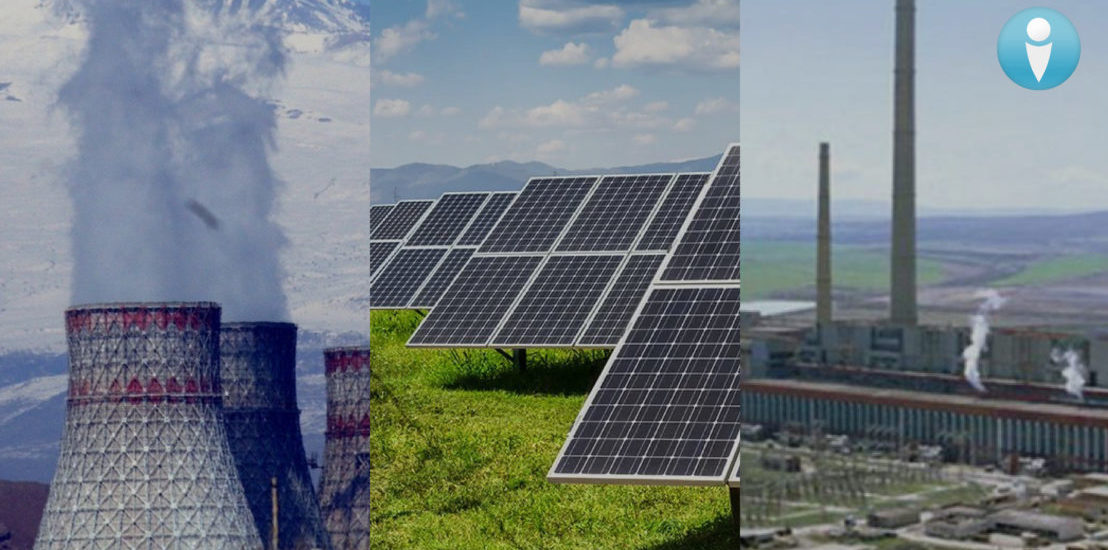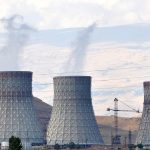- 31 May, 2024
- Economy and Energy

Although security has recently become the most heated topic of discusion in Armenia, it is mainly related to its military-political component, completely ignoring a number of areas of national security: energy, food, water, etc. This can have much more profound and immediate consequences than many realize. Below we will capture the main issues of energy security in Armenia and what the state needs to do.
Components
On the one hand, Armenia has a fairly diversified electricity production. Its three main components include thermal power plants, hydroelectric plants and nuclear power plants. Here, it is important to note the increasingly growing role of solar plants, but the three aforementioned components ensure more than 90 percent of the production. However, on the other hand, two of the mentioned components already imply dependence on external, mainly Russian imports. Thermal power plants run on gas, while the gas is almost entirely imported from Russia. The nuclear power plant works with uranium fuel, which is also imported from Russia, moreover, the nuclear waste of the nuclear power plant is exported to Russia, because Armenia, for objective reasons, does not have the capacity of long-term conservation of nuclear power plant waste (these wastes remain radioactive for thousands of years). Transportation and heating fuel imported to Armenia is also related to energy security issues. In both cases, it is mostly Russian natural gas.
There is also an issue of Russia’s excessive influence and presence in the electricity transmission market. Electric Networks of Armenia (ENA), i.e. Armenia’s main electricity transmission company, is owned by Russia-based oligarch Samvel Karapetyan. Furthermore, after the recent liberalization of the sector, despite the main objective of that process – limiting the monopoly of the ENA, there are circulating reports that some of the new companies are directly or indirectly linked to the owners of the ENA. If this information is correct (to be verified), there is a big problem even with the “reform” that has already been implemented.
Thus, the described picture shows that the current level of dependence of Armenia on Russia in the energy sector is simply enormous. This image cannot but cause alarm, considering the imperative of foreign policy diversification and reduction of Russian influence in Armenia. The presence of this picture combined with the geopolitical and regional situation and the current state of interstate relations make the hybrid blows on Armenia by the Russian Federation quite probable using the instrument of Armenia’s energy dependence.
Conceptual basis of energy security
Ensuring energy security of RA is one of the inalienable components of national security. In the field of energy security, RA must pursue or meet five main directions/criteria: 1) availability; 2) accessibility; 3) energy efficiency; 4) sustainability; and 5) transparency.
It is also important to note that:
- Increased consumption of cheap gas supplied from Russia maintains and deepens Armenia’s dependence on imported energy sources.
- The policy promoting the reduction of natural gas consumption and the spread of electric heating equipment, electric and non-natural gas-powered transport will contribute to the increase in the use of local renewable resources and other hydrocarbon resources, that is, to the weakening of energy dependence on Russia.
- According to modeling, in 2036, it will be possible to have grid-connected solar capacities of 1500 MWt of nominal capacity in Armenia, which, due to a number of circumstances, are mainly suitable for export. Therefore, it is necessary to work both on the formation of these capacities and the formation of the export markets for their outputs.
- Ensuring the synchronization of the electrical networks of Armenia and Georgia is essential.
- State investments in the field of energy saving are essential.
- Management and operation of the field as transparent and fair as possible are essential.
Solutions
Solar and battery plants. The main obstacle to the development of solar energy is the non-guaranteed output. In other words, there is electricity generation only during the daytime and only in sunny weather. This cannot be a stable basis from the perspective of the development of the energy system, because the main share should belong to the guaranteed capacities (NPP, thermal power station, HPP are classically considered to be such). In the case of Armenia, the problem is even more tangible, because solar energy is difficult to combine with a system with a large share of NPP, because increasing and decreasing the power of NPP depending on the time of day is problematic. But there are solutions here.
As mentioned, the main problem of solar plants is lack of guarantee or instability, which can be solved by creating energy storage, battery plants. For mountainous countries like Armenia, the energy storage system through two reservoirs can be quite a logical solution. Next to the solar plant, two reservoirs with controllable connection with each other can be built, one of which is in a higher position than the other (for example, one in the Ararat valley, the other the Vedi reservoir currently under construction). In sunny weather, when the plant has additional or relatively cheap energy output, the generated energy is used to pump water from the lower reservoir to the upper reservoir, and in the case of an acute need for electricity and the absence of sunlight, water is released from the upper reservoir and energy is generated by hydropower. This is a unique combination of solar plant and HPP technologies, which, of course, increases the price of the produced energy compared to only solar or only HPP, but also solves the main problem of solar energy of not being guaranteed.
At the same time, it is required to consider the possibility of covering newly constructed and existing reservoirs with artificial materials that reduce evaporation (like the plastic balls used in California). In case of best performance, it is possible to approach a closed cycle model between two reservoirs, even with losses.
Connection with Georgia. The construction project of the 4th high-voltage power line with neighboring Georgia is of special importance. First of all, this project is economically justified. In 2022, 24% of the electricity exported from Armenia went to Georgia. According to Hakob Vardanyan, Deputy Minister of Territorial Administration and Infrastructure, in 2022, Armenia exported more electricity to Georgia than in the previous 10 years. In the mentioned year, Armenia exported 365 million kWh to Georgia, while from 2012 to 2021 inclusive, 242 million.
As mentioned, currently there are three power transmission lines between Armenia and Georgia, but they are not enough to create a synchronized connection between Armenia and Georgia. In case of the construction of the 4th power line, Armenia and Georgia can discuss the possibility of entering into a synchronous connection of electricity, which in turn will significantly improve the current risks in the field of electricity production. In the case of a sudden stop of gas supplies to Armenia or an unreasonable increase in the price of gas, and therefore complications in the operation of thermal power plants, the risk of intermittent outages will decrease in the country.
Moreover, in substantive terms, it will make sense to connect to the EU Black Sea Global Gateway project initiated by the EU, i.e. the power cable that will pass through the bottom of the Black Sea, which, in turn, will make it logical to build a possible solar energy production capacity of 1500 MWt for Armenia by 2036, because Armenia will be connected to the market that will always need this green energy. However, it has been almost 10 years since the 4th Armenian-Georgian power line project is in the design and estimation phase.
The new nuclear power plant. The life span of the currently operating Metsamor nuclear power plant can no longer be extended, and 2036 is the last date for the operation of this nuclear power plant. In order for Armenia to have a nuclear alternative when the Metsamor nuclear power plant expires, the construction of the new plant(s) should begin as soon as possible. On average, such constructions take 10 years or more. Given the pace of decision-making in Armenia, the poor quality of governance and frequent construction problems, Armenia will likely need more than 10 years. So, it can already be noted that the decisions regarding the new nuclear power plant are delayed. Regardless of whether we are talking about Korean or American (modular) reactors, their construction should start today. Before the end of 2036, it is necessary to develop scenarios for the the formation of alternative pathways ofe conservation of fuel imported from Russia for the nuclear power plant and the waste produced by the nuclear power plant. Kazakhstan can be a potential candidate to replace Russia in this matter.
Diversification of natural gas. Diversification of sources of natural gas imported to Armenia is paramount. The most probable source is, of course, Iran, with which Armenia already has relevant infrastructures, which, however, currently belong to the Russian company “Gazprom.” However, it is important to keep in mind that this ownership is the result of the special price set for Armenia and if the logic of the special price is violated, Armenia should reserve the right to review the ownership of the Armenia-Iran pipeline or the Armenian gas pipeline in general. From the perspective of diversification of natural gas sources, it is necessary to develop scenarios to ensure possible imports and infrastructures from Azerbaijan (in case of signing a peace agreement), Middle Asia and Iraq.
Taking into account the fact that natural gas is the most vulnerable option as an imported source of energy, due to its transportation characteristics, a state approach is needed toward increasing natural gas saving measures and actions (thermal insulation, energy saving), on the one hand, and on the other hand, increasing the use of alternative fuels to natural gas with tax incentives (gasoline, liquefied gas). Such a measure can be considered to exempt the mentioned two products from excise tax and VAT.
Distribution diversification. The state should continue the policy of further liberalization of the sector, and increase of transparency. It should be kept in mind that ENA cannot continue to belong to a Russia-based oligarch in the mid-term perspective and cannot continue to maintain its monopoly position.
New HPPs on Araks river. It is required to carry out research on the possibilities of building potential new joint (Armenian-Turkish) HPPs on the transboundary waters (Araks). This will not only contribute to the enhancement of Armenia’s energy security, mainly at the expense of water resources outflowing from Armenia’s borders, but will also enrich the Armenian-Turkish cooperation agenda.
To sum up, it should be noted that ensuring energy security, combined with a number of other dimensions of the concept of security, is exactly the homework that the professional community of Armenia has been talking about for a long time. In the increasingly escalating context of Armenian-Russian relations, the execution of this homework becomes the number one responsibility of the government of the Republic of Armenia.
Areg Kochinyan
Union of Informed Citizens




